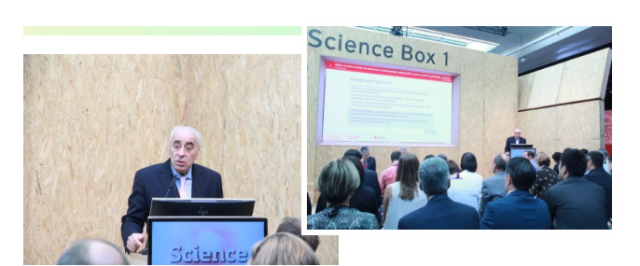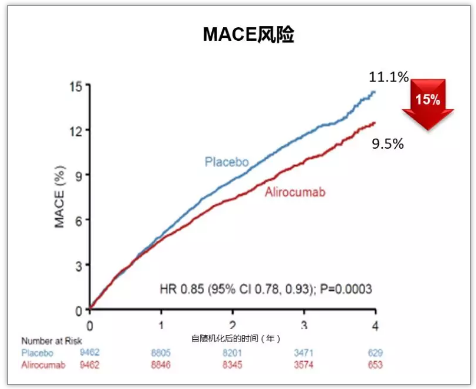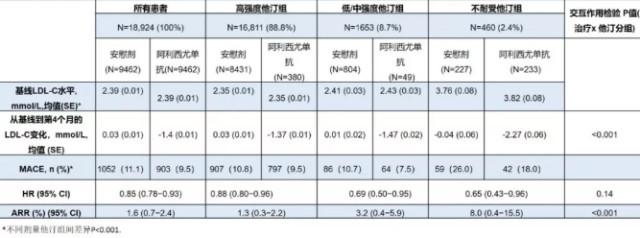阿利西尤单抗用于不耐受高剂量他汀的 ACS 患者疗效更佳
中国医学论坛报 9 月 3 日
急性冠脉综合征(ACS)患者面临较高的残留风险,该风险部分与 LDL-C 水平相关。而他汀类降脂药物是治疗冠心病的基石 [1]。ODYSSEY OUTCOMES 研究已经证实对于近期发生 ACS 且经强化降脂而血脂水平不达标的患者,阿利西尤单抗可显著降低主要不良心血管事件(MACE 事件)发生率 [2]。在本届 ESC 年会上,研究者发布的 ODYSSEY OUTCOMES 他汀强度亚组分析研究了 ODYSSEY OUTCOMES 研究中阿利西尤单抗对使用不同剂量他汀类药物的近期发生 ACS 的患者临床结局的影响。

研究者在现场报告
研究方法
ODYSSEY OUTCOMES 研究共纳入 18,924 例近期发生 ACS 且经强化他汀治疗血脂仍未达标的患者,在维持现有治疗的基础上随机分为两组:阿利西尤单抗干预组(75 mg SC Q2W,可能上调至 150 mg Q2W)及安慰剂组。其中强化他汀治疗包含下列情况:高强度(阿托伐他汀每天 40~80 mg 或瑞舒伐他汀每天 20~40 mg)、最大耐受剂量他汀类药物及不能耐受他汀类药物。中位随访时间为 2.8 年。
研究的主要终点是 MACE 事件,包括 CHD 死亡、非致死性 MI、缺血性卒中或需要住院治疗的不稳定型心绞痛。
在基线时依据他汀类药物剂量对患者进行分组:高强度他汀组(88.8%)、低强度或中等强度他汀组(8.7%)及不耐受他汀组(2.4%)。分析每组的 MACE 事件相对 [风险比 (HR)] 和绝对风险降低(ARR)。
研究结果
总体而言,阿利西尤单抗显著降低了 MACE 事件发生率(HR 0.85,95%CI 0.780.93,P <0.001,图)。其中不耐受高强度他汀的 ACS 患者(低/中强度他汀组及不耐受他汀组)MACE 事件发生率较高强度他汀组更低,但各强度他汀组中 HR 无统计学差异(表)。

图 两组患者的 MACE 事件发生率

表 不同亚组患者的 LDL-C 水平及变化、MACE 风险
高强度他汀组、低/中等强度他汀组和不耐受他汀组的基线 LDL-C 水平均显著高于目标值,其中,不耐受他汀组最高。相应地,安慰剂组的 MACE 事件发生率也显著高于阿利西尤单抗组,且不耐受他汀组的 MACE 事件发生率最高;高强度他汀组、低/中强度他汀组及不耐受他汀组 MACE 事件发生率分别为 10.8%、10.7% 和 26%。
使用阿利西尤单抗治疗后,LDL-C 从基线到第 4 个月的平均降幅在 3 组中均增加。相应地,MACE 的 ARR 分别为 1.3%、3.2% 和 8.0%(交互作用检验 P<0.001)。
研究结论
在 ODYSSEYOUTCOMES 研究中,无法接受高强度他汀类药物及不能耐受他汀类药物治疗的患者,经阿利西尤单抗治疗后,MACE 事件绝对风险更低,且 LDL-C 基线水平越高,LDL-C 的绝对降幅越大。发生 ACS 后无法接受高强度他汀类药物治疗的患者应考虑阿利西尤单抗治疗。
展望
2012 年全国调查结果显示,中国成人血脂异常总体患病率达 40.40%[3]。人群血清胆固醇水平的升高将导致 2010 年~2030 年期间我国心血管病事件约增加 920 万 [4]。预示未来中国成人血脂异常患病及相关疾病负担将继续加重。而既往流行病学研究及临床试验均提示中国人群对于大剂量、高强度他汀类药物治疗的耐受性和安全性较差,发生肝毒性、肌肉毒性的风险高于欧美国家患者 [5-8]。ACC/AHA 也强调高强度、大剂量他汀类药物治疗不适用于亚裔人群 [9]。故而结合此次刚刚在 ESC 发布的 ODYSSEY OUTCOMES 他汀剂量亚组分析的结果,阿利西尤单抗或可为中国不耐受高剂量他汀的 ACS 患者带来明显的获益。
参考文献
[1] A.L. Catapano, I. Graham, G. De Backer, O. Wiklund, M.J. Chapman, H. Drexel, A.W. Hoes, C.S. Jennings, U. Landmesser, T.R. Pedersen, Z. Reiner, G. Riccardi, M.R. Taskinen, L. Tokgozoglu, W.M.M. Verschuren, C. Vlachopoulos, D.A. Wood, J.L. Zamorano, M.T. Cooney, E.S.C.S.D. Group, 2016 ESC/EAS Guidelines for the Management of Dyslipidaemias, European heart journal, 37 (2016) 2999-3058.
[2] G.G. Schwartz, P.G. Steg, M. Szarek, D.L. Bhatt, V.A. Bittner, R. Diaz, J.M. Edelberg, S.G. Goodman, C. Hanotin, R.A. Harrington, J.W. Jukema, G. Lecorps, K.W. Mahaffey, A. Moryusef, R. Pordy, K. Quintero, M.T. Roe, W.J. Sasiela, J.F. Tamby, P. Tricoci, H.D. White, A.M. Zeiher, O.O. Committees, Investigators, Alirocumab and Cardiovascular Outcomes after Acute Coronary Syndrome, The New England journal of medicine, 379 (2018) 2097-2107.
[3] 诸骏仁, 高润霖, 赵水平, 陆国平, 赵冬, 李建军, 中国成人血脂异常防治指南 (2016 年修订版), 中国循环杂志, 31 (2016) 937-953.
[4] A. Moran, D. Gu, D. Zhao, P. Coxson, Y.C. Wang, C.S. Chen, J. Liu, J. Cheng, K. Bibbins-Domingo, Y.M. Shen, J. He, L. Goldman, Future cardiovascular disease in china: markov model and risk factor scenario projections from the coronary heart disease policy model-china, Circulation. Cardiovascular quality and outcomes, 3 (2010) 243-252.
[5] S. Zhao, Y. Wang, Y. Mu, B. Yu, P. Ye, X. Yan, Z. Li, Y. Wei, B.M. Ambegaonakr, D. Hu, D.Y.-C.S. Investigators, Prevalence of dyslipidaemia in patients treated with lipid-lowering agents in China: results of the DYSlipidemia International Study (DYSIS), Atherosclerosis, 235 (2014) 463-469.
[6] F. Wang, P. Ye, D. Hu, Y. Min, S. Zhao, Y. Wang, Y. Mu, X. Yan, Z. Li, Y. Wei, J. Li, D.Y.-C.S. Investigators, Lipid-lowering therapy and lipid goal attainment in patients with metabolic syndrome in China: subgroup analysis of the Dyslipidemia International Study-China (DYSIS-China), Atherosclerosis, 237 (2014) 99-105.
[7] Y. Li, S.P. Zhao, P. Ye, X.W. Yan, Y.M. Mu, Y.D. Wei, D.Y. Hu, D.Y.-C.S. Investigators, [Status of cholesterol goal attainment for the primary and secondary prevention of atherosclerotic cardiovascular disease in dyslipidemia patients receiving lipid-lowering therapy: DYSIS-China subgroup analysis], Zhonghua xin xue guan bing za zhi, 44 (2016) 665-670.
[8] H.T.C. Group, HPS2-THRIVE randomized placebo-controlled trial in 25 673 high-risk patients of ER niacin/laropiprant: trial design, pre-specified muscle and liver outcomes, and reasons for stopping study treatment, European heart journal, 34 (2013) 1279-1291.
[9] N.J. Stone, J.G. Robinson, A.H. Lichtenstein, C.N. Bairey Merz, C.B. Blum, R.H. Eckel, A.C. Goldberg, D. Gordon, D. Levy, D.M. Lloyd-Jones, P. McBride, J.S. Schwartz, S.T. Shero, S.C. Smith, Jr., K. Watson, P.W. Wilson, G. American College of Cardiology/American Heart Association Task Force on Practice, 2013 ACC/AHA guideline on the treatment of blood cholesterol to reduce atherosclerotic cardiovascular risk in adults: a report of the American College of Cardiology/American Heart Association Task Force on Practice Guidelines, Journal of the American College of Cardiology, 63 (2014) 2889-2934.